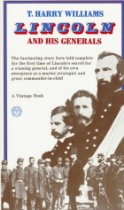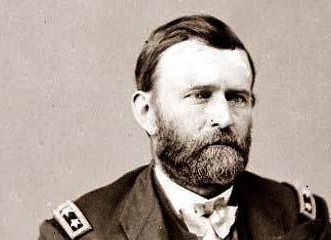Posts Tagged ‘Grant’
Book Review: Lincoln and His Generals
 T. HARRY WILLIAMS. Lincoln and His Generals. New York: Random House, 1952. Pp. viii, 363, $2.40.
T. HARRY WILLIAMS. Lincoln and His Generals. New York: Random House, 1952. Pp. viii, 363, $2.40.

T. Harry Williams
Over half a century ago, T. Harry Williams wrote an exceptional work with as major theme that the performance of President Abraham Lincoln as commander in chief during the American Civil War positioning him as the true director of the war efforts of Northern armies and the progenitor of the country’s first modern command system. He shows Lincoln to be an able student of military strategy who ramped up quickly, grasped the end game and generally how to reach it, but struggled to find the right executioner of those plans. That he was even more skilled as a politician meant that he functioned superbly as leader in both political and military spheres throughout the conflict.
This is a work about the challenges of leadership set against what Williams calls the first of the “modern total wars.” (3) Williams chronicles the war from Lincoln’s perspective presenting the strengths and, more notably, the many foibles of the men who served the North in senior military positions. Their relative caliber appears to have been directly correlated to the attention Lincoln had to give them. More attention from and scrutiny by Lincoln was thus not a mark of achievement. Williams’ work reflects that relative attention. For example, he begins his discussion of McClellan in Chapter 2 and does not finish with him until Chapter 8 at which point Lincoln finally dismisses McClellan in disgust. (179) Williams takes his readers through the agonizing months Lincoln spent attempting to manage McClellan and his paranoia regarding enemy troop strength and inability to execute when it would put his men in harm’s way or there was the potential to fail. Grant, by contrast to McClellan, received some but not extensive coverage by Williams reflecting Lincoln’s own confidence that Grant could carry forward Lincoln’s strategic aims effectively. Williams concludes that in the waning months of 1864, Lincoln had sufficient trust in Grant to intervene little in the war’s management. That is not to say that Lincoln shrugged off any responsibility in setting strategic direction or in monitoring closely “and sometimes anxiously” the conduct of the war. (336) He was quick to reset direction when required.

Williams’ organization of the book is driven largely by the order of his encounters with senior military leaders. He begins with the infamous but corpulent and declining General Winfield Scott. We are given images of Lincoln chatting by the fire in Scott’s drawing room about daily reports and strategic options. Lincoln begins to reveal his own nascent military strategies and to measure those proposed by the militarist Scott against civilian and political realities. Lincoln also demonstrates an important resolve to make and stand by decisions even if they go against those of senior military advisors. Williams provides illustration of this by pointing to Lincoln’s grasping of the strategic golden nugget within Scott’s Anaconda Plan of control of the Mississippi but Lincoln’s rejection of its execution because it risked a drawn out and uncertain resolution.
Regular army man Irvin McDowell is then tagged by Lincoln to take command of the swelling number of troops in and around Washington, a number that by the summer of 1861 exceeded 30,000 men. Lincoln pushes McDowell, of course, into an offensive movement at Manassas to disastrous results. While the mark against McDowell’s mediocre reputation is severe, Williams allows us to see that Lincoln is willing to bear some of the blame.
The scene is thus set for the summoning of McClellan to Washington. This begins Lincoln’s relationship with “the problem child of the Civil War.” (25) Williams chronicles the early months of McClellan’s experiences in the East, his messianic complex, disrespect for Lincoln and others with whom he had to deal, and the efforts that Lincoln had to make to manage a man who held such promise but failed to deliver. It is clear that Lincoln, to this credit, attempted many different techniques in his efforts to supervise McClellan.
John C. Fremont, McClellan’s peer in the Western Department and a political appointment made by Lincoln himself, proves disastrous in his mismanagement of Missouri and a bitter disappointment. Williams captures well the odd quirks of both Fremont and the Blair family, his patrons, and the lengths to which Lincoln had to go to remove him.
Halleck is portrayed as only marginally effective and jealous enough of Grant’s successes in the field to take credit for them. (61) His self-directed shift to subordinate role as coordinator and communicator between Lincoln and his staff is fascinating.
Other commanders are mentioned primarily for their lack-luster performances including Rosecrans, Buell, Thomas, Banks, and Butler to name a few. Williams’ provides an excellent summary of each man including physical characteristics, approach to command, reputation, and personality traits. He often reveals the quirks or failings that made them less than acceptable as senior command candidates. For example, he describes Benjamin F. Butler as “ingenious, resourceful, and colorful, but …no field general.” (188) Williams’ description of Rosecrans reveals a well researched sum of the man from his “intensified Roman nose” to his “good strategic sense and aggressive instincts.” (186-187) But he is thorough enough to point to Rosecrans weaknesses including a lack of “balance and poise that a great commander should have” which revealed a man unable to “control himself and the situation.” (187)
Clearly apparent in this history is that Lincoln, while climbing a steep learning curve, became an astute war strategist. In fact, Williams contends that the notion of “total war” as a means of destroying the Confederate Army was identified earliest and most enthusiastically as a strategic plank by Lincoln who “saw the big picture” better than most of his commanders and staff. (7) He further asserts that no one in the military leadership of either side had the experience to wage war at the scale that would be America’s Civil War. Both sides shared an equal innocence of the knowledge war making. (4) That said, Lincoln’s performance when viewed against that of Davis is all the more impressive.

Williams points out that Lincoln exhibited many good qualities as a leader. By example, he was not quick to claim credit for the successes of Sherman, even though he would have been justified to do so given the strategic direction he provided. Rather, Lincoln showered praise on men whose efforts were successful. He seemed to simply want vigilance and self-reliance from his commanders, both qualities he saw in Grant. (315)
Williams’ use of primary sources is impressive and adds credibility to his conclusions. Many citations were from actual correspondence or official records of exchanges between Lincoln and his team or Halleck and the field commanders. This depth of research adds much to the work.
At the time of publication, this book was the only one to fully examine Lincoln’s performance as commander in chief and stood as such for many years. Interestingly, in 2009, historian James McPherson visited the same topic and drew much from Williams’ foundation in his work, Tried by War: Abraham Lincoln as Commander in Chief. While good, I find it no better and in many ways a rehashing of Williams’ work, one that continues to stand on strong scholarship and goes far toward explaining Lincoln’s brilliance as both politician and military strategist.
Emulate Grant! Leadership in the American Civil War
I wrapped up reading Lincoln and His Generals by T. Henry Williams and found it quite good.
I confess to being impressed by the extent to which Lincoln became an able strategist by the mid-point of the war. No doubt contributing to this was Halleck’s liaise-faire attitude. Lacking a strong military leader and much in the way of battle successes, Lincoln obviously felt compelled to step in and fill the strategic voids for his armies.
I was also struck by the characteristics that Lincoln valued and devalued in his generals. The lesson would serve many aspiring to leadership today. The takeaway?

Emulate Grant!
Don’t whine.
Do the best you can with what you’ve been given.
Communicate minimally but effectively “up.”
Respect and follow the leadership of the man in charge when it is offered. Don’t argue with him excessively.
Don’t aspire to take his job, at least overtly.
Don’t criticize or blame others. Respect your subordinates enough to let them do their jobs.
Do not overly criticize them either. Control yourself and your emotions.
Be decisive.
Be manically focused on getting the job at hand done.
Be informed by the past but fully engaged in the realities of the present.
For Grant and Lincoln, this latter point meant something more than merely implementing Jominian tactics. It appears that together, they evolved toward the modern notion of war as “total” in Clausewitzian terms. Is it possible that only Lincoln saw this truth in the war’s earliest years? I say yes.
Military History Factoid of the Day – On Grant
When Grant became General in Chief of northern armies in 1864, he was 42 years old, 5’8″ tall and weighed 135 pounds.

This Weekend’s Reading: “Grant” and “Lincoln and His Generals”
I’m reading this weekend for class, Lincoln and His Generals by T. Harry Williams.
For pleasure, I’m reading Grant by Jean Edward Smith, this on my Kindle.
Beginning a search for a thesis topic…The American Civil War
I am going to begin in earnest to find a suitable topic for my thesis. I don’t expect to have one locked in until I get another course or two under my belt but I am interested in the opinions of many of you who I would consider expert on topics of Civil War military history. Where are there gaps in scholarship that need filling from your perspective?
Let me hear from you!
May Civil War and Military History Book Acquisitions – II
Continuing with my May book acquisitions which illustrate, as said by Civil War Interactive’s comments on my blog this week, why bank robbery may be needed to support my book-buying habits…
This looks like a great read. Author Tom Wheeler, an accomplished man by any measure, has a terrific website here with more about his book and research. This has moved to the top of my list of reading for between terms.
I have DISCOVERED Dr. Hess and the growing list of terrific titles he has published on the Civil War. No doubt his other books will show up in my library before long. Dr. Hess, who has impressive academic credentials, has a website here. His book, Pickett’s Charge: The Last Attack at Gettysburg, was nominated for a Pulitzer Prize.
I’ve been intending to pick this up. Authored by military history professor and fellow blogger Mark Grimsley, it too is at the top of my reading list. Dr. Grimsley’s OSU webpage is here. His blog is here.
My post, “Fabian Strategy and the American Civil War” here, lead me to this book. One of my readers recommended it and suggests that it proves that the Confederacy could not have used the Fabian strategy effectively. I’m looking forward to this one.
Jav Luvaas is another prolific writer of military history and my collection of his books is growing. I first discovered his work while taking the course, Great Military Philosopers (see “The Courses” page here for details. I picked up his titles: Napoleon on the Art of War and Frederick the Great on the Art of War.
I’ll be adding these authors to my “The Historians” page shortly.

























































